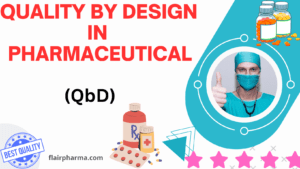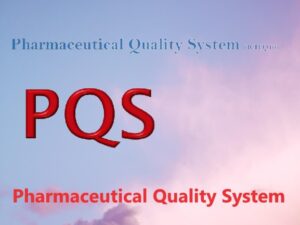The revolutionary approach to pharmaceutical development and manufacturing with Quality by Design (QBD). From systematic development processes to real-time monitoring and continuous improvement, QbD ensures the production of high-quality, safe, and effective drugs, transforming the industry’s landscape.
Quality by Design (QbD) represents a paradigm shift in the pharmaceutical industry, emphasizing a systematic and science-based approach throughout the drug development and manufacturing lifecycle. Unlike traditional methods, which often relied on empirical and trial-and-error approaches, QbD integrates principles of risk management, process understanding, and continuous improvement.
Key Components of Quality by Design:
- Systematic Development:
- QbD starts with a thorough understanding of the product and the process. It employs tools like Design of Experiments (DOE) and risk assessments to systematically identify critical factors influencing product quality.
- Risk Management:
- QbD employs risk management tools such as Failure Mode and Effects Analysis (FMEA) to proactively identify and mitigate potential risks throughout the development and manufacturing processes.
- Design Space:
- A critical concept in QbD, the design space defines the range of process parameters within which a product can be consistently manufactured to meet its desired quality attributes. This provides flexibility while ensuring product quality.
- Control Strategy:
- QbD emphasizes the development of a robust control strategy that includes real-time monitoring and control of critical parameters. Process Analytical Technology (PAT) is often employed to facilitate immediate detection and correction of deviations.
- Continuous Improvement:
- QbD fosters a culture of continuous improvement by leveraging data and insights gathered during the development and manufacturing processes. This iterative approach allows for ongoing optimization and innovation.
- Patient-Centric Approach:
- Quality by Design places a strong emphasis on understanding and controlling critical quality attributes (CQAs) that directly impact patient outcomes. This patient-centric focus ensures the safety and efficacy of pharmaceutical products.
- Efficiency and Resource Utilization:
- QbD leads to more efficient processes by reducing the need for extensive end-product testing. Resources are optimized based on a deep understanding of critical parameters, resulting in streamlined and cost-effective manufacturing.
- Regulatory Compliance:
- The QbD approach emphasizes proactive compliance through comprehensive documentation of development and manufacturing processes. This collaborative approach with regulatory agencies facilitates faster approvals.
Quality by Design is a holistic and transformative approach that not only meets regulatory requirements but also elevates the pharmaceutical industry’s standards. By integrating scientific principles, risk management, and continuous improvement, QbD ensures the consistent production of high-quality pharmaceuticals, ultimately benefiting patients worldwide.
Quality by design definition:
Quality by Design (QbD) is a systematic and science-based approach to pharmaceutical development and manufacturing that integrates quality considerations throughout the entire product lifecycle, ensuring the consistent production of high-quality drugs with a focus on patient safety and efficacy.
Quality by design Principles
Quality by Design (QbD) is a systematic and science-based approach to pharmaceutical development and manufacturing that integrates quality into every stage of the product lifecycle. The principles of QbD are outlined by regulatory agencies, including the U.S. Food and Drug Administration (FDA), and are designed to ensure the production of high-quality drugs with a focus on patient safety and efficacy. Here are the key principles of Quality by Design:
- Define Objectives with a Quality Target Product Profile (QTPP):
- Clearly define the desired attributes of the final product, encompassing safety, efficacy, and quality characteristics. The Quality Target Product Profile (QTPP) serves as a comprehensive guide for the development process.
- Identify Critical Quality Attributes (CQAs):
- Identify and prioritize the critical quality attributes (CQAs) of the product, which are the key characteristics that directly impact safety and efficacy. Understanding and controlling these attributes are crucial for meeting quality objectives.
- Understand and Define the Design Space:
- Establish a design space that encompasses the range of input variables and process parameters within which the product can be manufactured to meet the defined CQAs. The design space provides flexibility while ensuring product quality.
- Risk Assessment and Management:
- Employ risk management tools, such as Failure Mode and Effects Analysis (FMEA), to systematically identify and assess potential risks to the product and the manufacturing process. Develop strategies to mitigate these risks proactively.
- Utilize Design of Experiments (DOE):
- Apply statistical design of experiments to systematically vary factors and understand their impact on the product. This allows for the identification of critical factors and interactions that influence the final product.
- Develop a Control Strategy:
- Formulate a robust control strategy that includes monitoring and control of critical process parameters. Real-time monitoring, often using Process Analytical Technology (PAT), allows for immediate detection and correction of deviations.
- Implement Real-Time Release Testing (RTRT):
- Shift from end-product testing to real-time release testing, where critical quality attributes are assessed during the manufacturing process. This facilitates immediate decision-making and reduces the reliance on extensive end-product testing.
- Continuous Improvement:
- Foster a culture of continuous improvement by leveraging data and insights gathered during the development and manufacturing processes. Implement iterative approaches to refine and optimize processes based on knowledge and experience.
- Knowledge Management:
- Accumulate and manage knowledge throughout the product lifecycle. Develop a deep understanding of the relationships between input variables, process parameters, and critical quality attributes. This knowledge guides decision-making and process optimization.
- Regulatory Collaboration:
- Collaborate with regulatory agencies throughout the development process. Provide transparent and comprehensive documentation of the QbD elements, facilitating a more streamlined regulatory review and approval process.
By adhering to these principles, pharmaceutical companies can ensure a comprehensive and systematic approach to drug development and manufacturing, resulting in consistent product quality and patient safety.
Advantages of Quality by Design (QbD) in Pharmaceuticals
| Advantage | Description |
|---|---|
| Enhanced Product Quality | – Systematic understanding of product and process variability leads to improved control. – Consistent product quality through identification and control of critical quality attributes (CQAs). – Reduction in batch-to-batch variability. |
| Risk Mitigation | – Early identification and mitigation of risks through tools like Failure Mode and Effects Analysis (FMEA). – Proactive management of potential issues, reducing the likelihood of product failures or deviations. |
| Cost Reduction | – Improved efficiency in the development and manufacturing processes.<br> – Reduction in the need for extensive end-product testing. – Minimization of costly deviations and rejections. |
| Faster Regulatory Approval | – Comprehensive understanding of the product and process facilitates regulatory submissions. – Enhanced communication with regulatory agencies due to transparent and well-documented processes. |
| Flexibility in Manufacturing | – Establishment of a design space allows for flexibility within defined parameters. – Adaptable processes that can accommodate variations without compromising quality. – Facilitates process optimization and continuous improvement. |
| Continuous Improvement Culture | – Encourages a culture of continuous improvement and learning. – Iterative process development allows for refinement based on gathered knowledge and data. – Opportunities for ongoing optimization and innovation. |
| Efficient Resource Utilization | – Focus on critical process parameters reduces the need for excessive testing and validation. – Efficient allocation of resources based on a deep understanding of factors influencing product quality. |
| Real-Time Monitoring and Control | – Implementation of Process Analytical Technology (PAT) enables real-time monitoring. – Immediate detection and correction of deviations, reducing the likelihood of producing out-of-specification products. |
| Patient-Centric Approach | – Emphasis on understanding and controlling critical quality attributes (CQAs) relevant to patient outcomes. – Increased confidence in the safety and efficacy of pharmaceutical products for patients. |
| Scientific Decision-Making | – Data-driven decision-making based on scientific principles. – Reduction in reliance on empirical knowledge, fostering a more systematic and informed approach to pharmaceutical development. |
| Global Harmonization | – Encourages global alignment and harmonization of pharmaceutical development and manufacturing practices. – Facilitates consistency in quality standards across different regions and markets. |
References: Understanding Pharmaceutical Quality by Design

